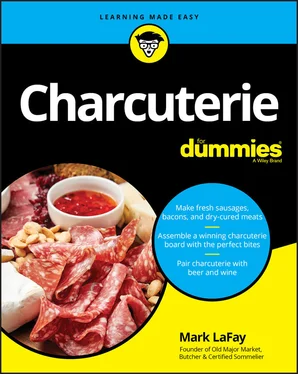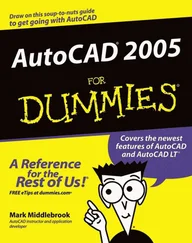
Charcuterie For Dummies®
Published by: John Wiley & Sons, Inc.,111 River Street, Hoboken, NJ 07030-5774, www.wiley.com
Copyright © 2020 by John Wiley & Sons, Inc., Hoboken, New Jersey
Published simultaneously in Canada
No part of this publication may be reproduced, stored in a retrieval system or transmitted in any form or by any means, electronic, mechanical, photocopying, recording, scanning or otherwise, except as permitted under Sections 107 or 108 of the 1976 United States Copyright Act, without the prior written permission of the Publisher. Requests to the Publisher for permission should be addressed to the Permissions Department, John Wiley & Sons, Inc., 111 River Street, Hoboken, NJ 07030, (201) 748-6011, fax (201) 748-6008, or online at http://www.wiley.com/go/permissions .
Trademarks:Wiley, For Dummies, the Dummies Man logo, Dummies.com, Making Everything Easier, and related trade dress are trademarks or registered trademarks of John Wiley & Sons, Inc., and may not be used without written permission. All other trademarks are the property of their respective owners. John Wiley & Sons, Inc., is not associated with any product or vendor mentioned in this book.
LIMIT OF LIABILITY/DISCLAIMER OF WARRANTY: WHILE THE PUBLISHER AND AUTHOR HAVE USED THEIR BEST EFFORTS IN PREPARING THIS BOOK, THEY MAKE NO REPRESENTATIONS OR WARRANTIES WITH RESPECT TO THE ACCURACY OR COMPLETENESS OF THE CONTENTS OF THIS BOOK AND SPECIFICALLY DISCLAIM ANY IMPLIED WARRANTIES OF MERCHANTABILITY OR FITNESS FOR A PARTICULAR PURPOSE. NO WARRANTY MAY BE CREATED OR EXTENDED BY SALES REPRESENTATIVES OR WRITTEN SALES MATERIALS. THE ADVICE AND STRATEGIES CONTAINED HEREIN MAY NOT BE SUITABLE FOR YOUR SITUATION. YOU SHOULD CONSULT WITH A PROFESSIONAL WHERE APPROPRIATE. NEITHER THE PUBLISHER NOR THE AUTHOR SHALL BE LIABLE FOR DAMAGES ARISING HEREFROM.
For general information on our other products and services, please contact our Customer Care Department within the U.S. at 877-762-2974, outside the U.S. at 317-572-3993, or fax 317-572-4002. For technical support, please visit https://hub.wiley.com/community/support/dummies .
Wiley publishes in a variety of print and electronic formats and by print-on-demand. Some material included with standard print versions of this book may not be included in e-books or in print-on-demand. If this book refers to media such as a CD or DVD that is not included in the version you purchased, you may download this material at http://booksupport.wiley.com . For more information about Wiley products, visit www.wiley.com .
Library of Congress Control Number: 2020904220
ISBN 978-1-119-69078-8 (pbk); ISBN 978-1-119-74869-4 (ebk); ISBN 978-1-119-74870-0 (ebk)
Charcuterie For Dummies®
To view this book's Cheat Sheet, simply go to www.dummies.comand search for “Charcuterie For Dummies Cheat Sheet” in the Search box.
Table of Contents
1 Cover
2 Introduction Introduction Since as far back as written history takes us, humans have been finding ways to evolve and improve; the result has been a constant evolution in how we live so that life can get easier. Think about the small things, like fire, the wheel, wielding fire, stone tools, metal tools, and so on. Arguably one of the greatest innovations for the human race was learning the art of cultivation and preservation. This led to a shift from a hunter-gatherer way of life to an agrarian culture where animals were domesticated, food was farmed, and methods of preservation were discovered and used so that humankind could weather the storms of four-season living and gradually start spreading out across the world. Maybe it’s this connection to the ways of old that is fueling a resurging interest in seasoning, salting, and preserving meats. Or it could be a pushback against the industrialization of the food system here in the United States. Whether we are romanticizing “the way it used to be” or simply looking for a better way to live in a modern world using influences from the past, the growing interest in artisanal meat craft is apparent. Charcuterie, a French word, has become a universal term (at least in the U.S.) for preserved meats. However, there is a historical significance to this word. Charcuterie is a craft of maximum utilization and preservation of harvested animals from a time when refrigeration was either limited or nonexistent and animal protein was a luxury, not a staple. Imagine that, a plate filled with potatoes and some meat, not meat and some potatoes. With charcuterie, you can give new life to artifacts of cultural heritage that have, until now, been relegated to the history books.
About This Book Foolish Assumptions Icons Used In This Book Beyond the Book Where To Go From Here
3 Part 1: Getting Started With Charcuterie Chapter 1: Get the Gear Meat Grinders Sausage Stuffers Meat Slicer Smokers Curing Chambers Scientific Meters Small Wares Properly Caring for Your Gear Shopping for Gear Locally Shopping for Gear Online Chapter 2: Working with Potentially Hazardous Food Personal Hygiene Before You Get Started Protecting Against Pathogens of Concern Pathogens of Concern How to Find Help Chapter 3: Quality In, Quality Out Thinking Twice about Commodity Protein Purchasing Protein from a Farmer Meat the Butcher Working with Wild Game Selecting Your Spices
4 Part 2: Making Meat Treats Chapter 4: Fresh and Dry-Cured Whole Muscles Fresh-Cured Bacons Dry-Cured Meats Curing Seafood Chapter 5: Grinding and Stuffing Sausage Grinding Sausages! Emulsified Sausages A Word about Casings Stuffing and Linking Sausage Chapter 6: Getting Fresh with Sausages Chapter 7: You Say Salami, I Say Salame Fermenting Sausage Ensuring Your Salami Is Secure with a Bubble Knot Molding the Next Generation of Salami Drying Your Salami
5 Part 3: Entertaining with Charcuterie Chapter 8: Always the Entertainer Sourcing Great Proteins Say Cheese Condiments and Accouterments Bringing It All Together! Chapter 9: Wine and Charcuterie Making Wine Red Wines White Wines Chapter 10: Beer and Charcuterie Making Beer Popular Beer Styles
6 Part 4: The Part of Tens Chapter 11: Ten Wines Under $25 to Impress Your Guests Joseph Drouhin Saint-Véran Chardonnay Pico Maccario Lavignone Barbera d’Asti Substance Cabernet Gouguenheim Malbec Reserva Pierre Sparr Cremant Rosé Theorize Zinfandel Roger Neveu Sancerre Angelo Negro Angelin Langhe Nebbiolo Mestres 1312 Cava Brut Reserva Campuget 1753 Rosé Chapter 12: Ten Meats You Must Try La Quercia Acorn Edition Prosciutto Smoking Goose Delaware Fireball Mousse de Foie Gras de Canard Grammy Mae’s Summer Sausage Figatelli from Les Cochons Tout Ronds 18-Month Prosciutto di Parma with Black Truffles Cinco Jotas Acorn-Fed Ibérico Ham Benton’s Hickory Smoked Bacon Brooklyn Cured Bresaola Mole Salami
7 Index
8 About the Author
9 Supplemental Images
10 Advertisement Page
11 Connect with Dummies
12 End User License Agreement
1 Chapter 1FIGURE 1-1: Meat grinder parts.FIGURE 1-2: Manual meat grinder.FIGURE 1-3: KitchenAid attachment port and grinder attachment.FIGURE 1-4: Electric meat grinder.FIGURE 1-5: Sausage grinder plates of different sizes.FIGURE 1-6: Vertical stuffer and parts.FIGURE 1-7: Bench clamps for your stuffer.FIGURE 1-8: Meat slicer slicing bacon.FIGURE 1-9: Electric smoker.FIGURE 1-10: Gas-burning smoker.FIGURE 1-11: Ready-made dry-curing chamber.FIGURE 1-12: Humidity and temperature control sensors for a homemade curing cha...FIGURE 1-13: Tube brushes for cleaning stuffing horns.FIGURE 1-14: Sausagemaker.com homepage.
Читать дальше













